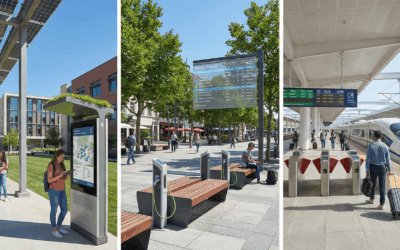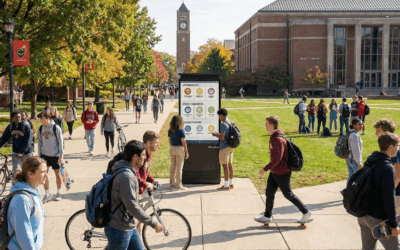A Campus at a Crossroads
University hallways have always been lined with posters, flyers, and bulletin boards shouting for student attention. Club nights. Cafeteria specials. Job fairs. The walls tell the story of campus life — but they’ve also symbolized something else: a missed opportunity.
While brands spend billions fighting for 18- to 25-year-old attention on TikTok and Instagram, universities already own the most valuable advertising space: their campuses. Thousands of young people, walking the same routes daily, standing in line at dining halls, congregating outside lecture halls.
And yet, most campuses still treat digital kiosks as information utilities: wayfinding maps, event calendars, static signage. Useful, yes. But financially? Passive.
That mindset is changing. The universities embracing digital kiosks as monetizable media platforms aren’t just upgrading communications. They’re building entirely new revenue engines at a time when tuition freezes, declining enrollments, and shrinking government funding are forcing finance teams to think differently.

From Posters to Platforms: The Shift in Campus Advertising
Advertising on campus isn’t new. From Coke sponsoring student fests to banks setting up credit card booths in student centers, brands have always chased young consumers on campus. But these traditional methods were fragmented and analog:
- Posters torn down as quickly as they go up.
- Tabling events limited to a few hours.
- Banners and sponsorships locked to sports teams.
Digital kiosks represent the next evolution. They aren’t just displays; they’re programmable, interactive, measurable. They sit in the busiest parts of campus, quietly accumulating thousands of impressions daily.
What used to be a static message board is now a dynamic channel, capable of hosting ads, promoting events, and even processing transactions.
For finance leaders, that’s not just modernization. That’s monetization.

Why Universities Are Finally Paying Attention
Three pressures are converging on higher education finance offices right now:
- Revenue diversification pressure → With enrollment challenges and tuition resistance, universities need non-tuition revenue.
- Digital transformation mandates → Students expect modern tech experiences everywhere, including campus comms.
- Advertiser demand → Brands are desperate to reach Gen Z authentically, and campus kiosks give them a captive audience.
This isn’t about slapping ads on a screen. It’s about reframing kiosks as part of the university business model.
How Kiosks Unlock Revenue — Without Eroding Student Experience
The natural skepticism is: “Are we just commercializing student life?” The answer lies in balance. The most successful universities aren’t running campuses like malls; they’re curating ad ecosystems that feel relevant, useful, and transparent.
- Targeted Ads with Student Value
Instead of irrelevant corporate ads, kiosks host student discounts, job fairs, and food delivery deals. Ads become information students actually want. - Sponsored Partnerships with Mission Fit
Banks sponsor financial literacy weeks. Tech companies sponsor hackathons. Sponsors gain visibility; students gain resources. - Student Union Revenue Models
Kiosks give student clubs affordable ad slots with analytics on reach. What used to be poster wars becomes a fairer, more efficient promotion system. - Transaction-Based Revenue
Ticketing for concerts, merch sales, and even printing credits can flow through kiosks — with universities taking a revenue share.
The result? Multiple revenue streams layered on one infrastructure investment.
What the Numbers Say
Let’s break it down for a mid-sized university with 10 kiosks in high-traffic zones:
- Local business ads: $500/kiosk/month → $60,000/year
- National brand sponsorships: $100,000/year
- Student club promotions: $25,000/year
- Event ticketing & service fees: $50,000/year
Total: $235,000/year in recurring revenue potential.
For finance officers, this is meaningful. For student unions, it’s transformative. For event organizers, it’s visibility that actually scales.

Stories from the Field
- A Midwest University partnered with a local bank to sponsor kiosks campus-wide. The bank got visibility; the university got $250K annually.
- An Australian university shifted concert ticketing to kiosks. Ticket sales jumped 30% because kiosks were placed where students naturally lingered.
- A European campus banned paper posters in favor of digital kiosks. Waste decreased dramatically, while student clubs gained fairer access to promotion.
These aren’t hypotheticals — they’re proof points that kiosks can shift from expense line items to ROI engines.
The Bigger Picture: Why This Matters Beyond Money
The most compelling part? Kiosks don’t just help balance budgets. They create a healthier campus ecosystem:
- Sustainability → Goodbye, paper posters.
- Equity → Student groups compete on equal footing with digital slots instead of whoever has the biggest print budget.
- Engagement Analytics → Universities finally know which events and messages actually reach students.
And for students? The ads they see are contextual — a café discount before lunch, an internship fair ad outside the library. Advertising becomes part of the student experience, not an intrusion.

The Bold Future of Campus Media
If you zoom out, kiosks are more than hardware. They’re part of a larger transformation: universities becoming media networks in their own right.
Think about it: A university with 20,000 students has the same captive audience as a small city. When campuses harness kiosks as ad platforms, they’re essentially building micro-networks that local businesses, national brands, and student groups all want access to.
By 2030, universities that integrate kiosks into their revenue strategies could reduce reliance on tuition hikes and state funding by millions — while also creating more vibrant, digitally native student experiences.
The universities that don’t? They’ll keep subsidizing old systems while watching brands redirect budgets elsewhere.
From Screens to Strategies
The story of campus advertising is shifting from bulletin boards and posters to interactive kiosks that deliver revenue, transparency, and sustainability.
Universities that still see kiosks as “signage” are missing the point. These are platforms — platforms that, if managed strategically, can:
- Generate six-figure annual revenues
- Strengthen corporate partnerships
- Empower student unions
- Enhance the campus experience
In the new age of campus advertising, the kiosk isn’t just a screen. It’s a strategy.




